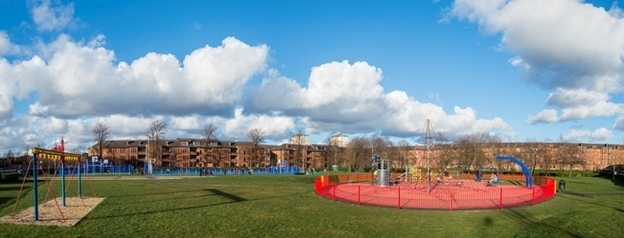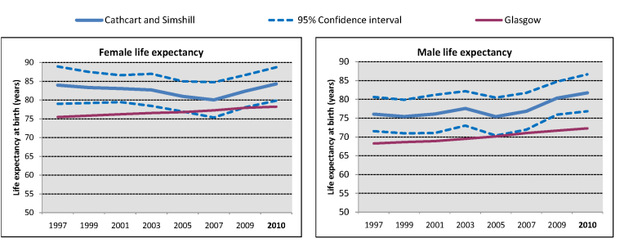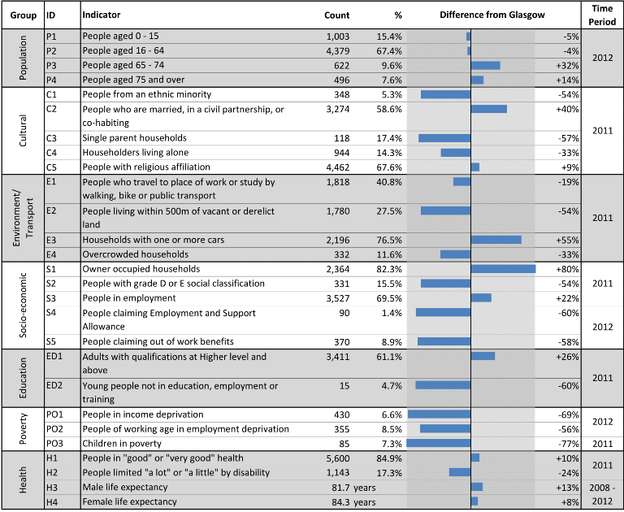Cathcart and Simshill
The profiles on these pages provide a comprehensive overview of health and wellbeing in Glasgow. There are 60 profiles in total, covering Glasgow as a whole, the three sub-sectors of the city (North East, North West and South Glasgow) and 56 neighbourhoods across the city. They highlight differences in health and life circumstances across the city for a range of indicators organised under broad themes: population; cultural factors; environment and transport; socioeconomic factors; education; poverty; and health. The profiles are intended to be a resource for local communities and to inform action at neighbourhood level.
Cathcart and Simshill
A printer friendly version of this sector profile can be downloaded here
Cathcart and Simshill is a neighbourhood in the south of Glasgow with a population of 6,500.
 Neighbourhood comparisons with Glasgow
Neighbourhood comparisons with Glasgow
Women in Cathcart and Simshill live, on average, two and a half years longer than men. The estimates of both male and female life expectancy in Cathcart and Simshill are considerably higher than the Glasgow average. The area has a high proportion of people in ‘good’ or ‘very good’ health and a low proportion of people are limited ‘a lot’ or ‘a little’ by disability compared with the Glasgow average. Eighty-two per cent of the households in Cathcart and Simshill are owner occupied.

Life expectancy for both males and females has risen in recent years in Cathcart and Simshill, and has stayed above the Glasgow average. In the most recent period shown (2008-12), life expectancy was also above the Scottish average for both males and females.
The overall population of Cathcart and Simshill fell by around 6% between 1996 and 2012. The decrease was mostly in the 0-15 and 16-44 age groups. The percentage of the total neighbourhood population from a minority ethnic group increased from 3% in 2001 to 5% in 2011, but remained below the Glasgow average from 2001 to 2011.
Notes
A document giving detailed notes and definitions for the information presented in this profile can be downloaded here.
An Excel workbook containing the data used in all of the profiles can be downloaded here. This workbook also includes alternative output formats and further breakdowns of some of the variables.
1. Data sources: Scottish Index of Multiple Deprivation (SIMD) 2012, Census 2011, Census 2001, HMRC, NOMIS, National Records of Scotland (NRS) and Scottish Government.
2. Populations presented in the population trend chart and used to calculate life expectancy estimates are taken from NRS small area population estimates and are based on: the 2001 census for the years 1996 - 2001; both the 2001 and 2011 census for the years 2002 - 2010; and the 2011 census for the years 2011-2012.
3. The Income deprivation and Employment deprivation indicators are derived from SIMD 2012, more information on this deprivation index can be found at: http://simd.scotland.gov.uk/publication-2012
4. Life expectancies are calculated based on population estimates and death registrations. 95% confidence intervals have been added on the graphs to give an indication of their accuracy. The x-axes of the life expectancy graphs give the mid-year for each life expectancy estimate e.g. 2010 represents the life expectancy estimate for the period 2008 – 2012.
Glasgow City Council have also produced neighbourhood profiles based on data from the 2011 Census which can be accessed via this link.







